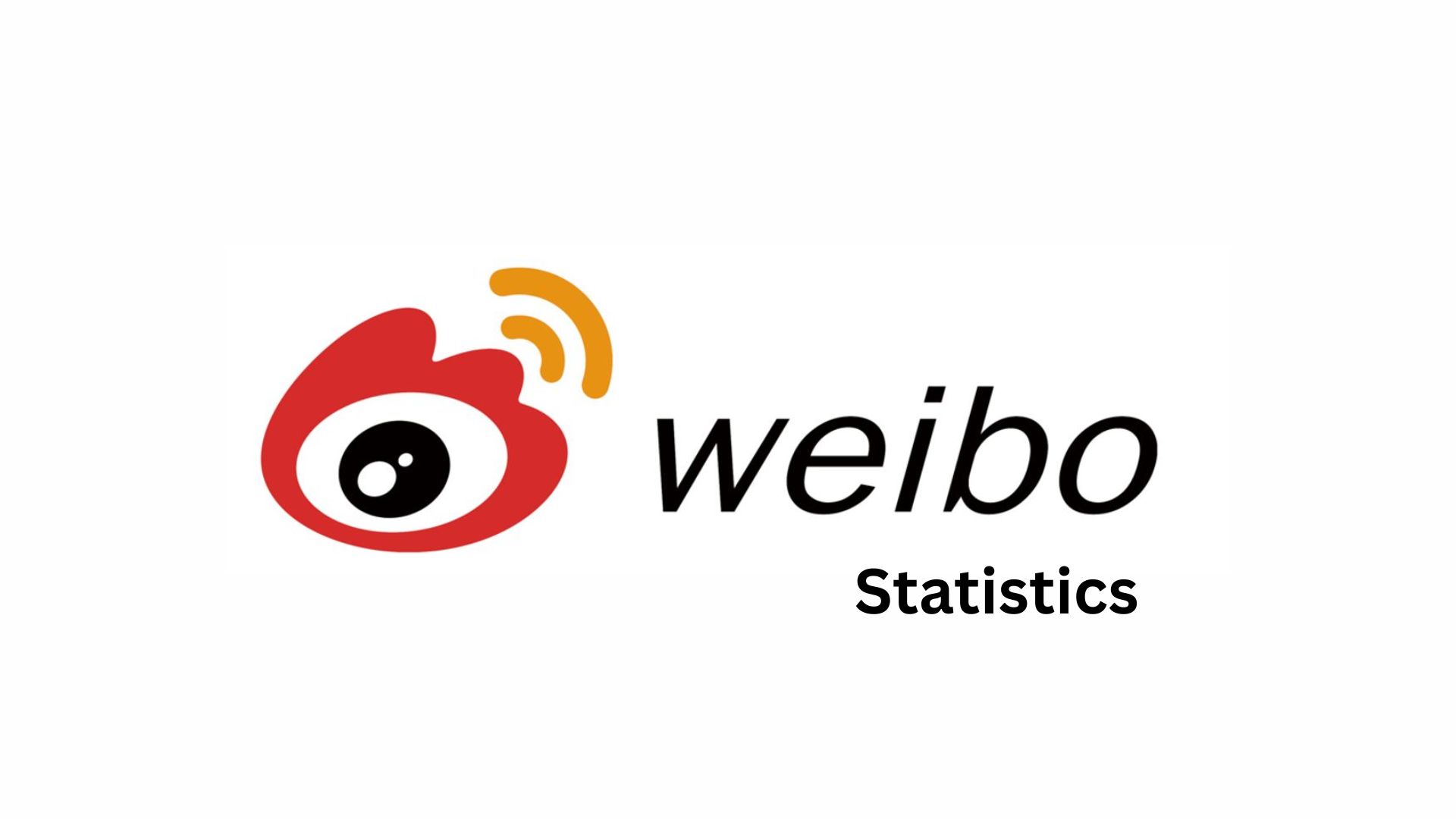Multicloud Statistics By Usage, Challenges, Market Size, Adoption, Strategies, Insight and Facts (2025)
Updated · Sep 30, 2025
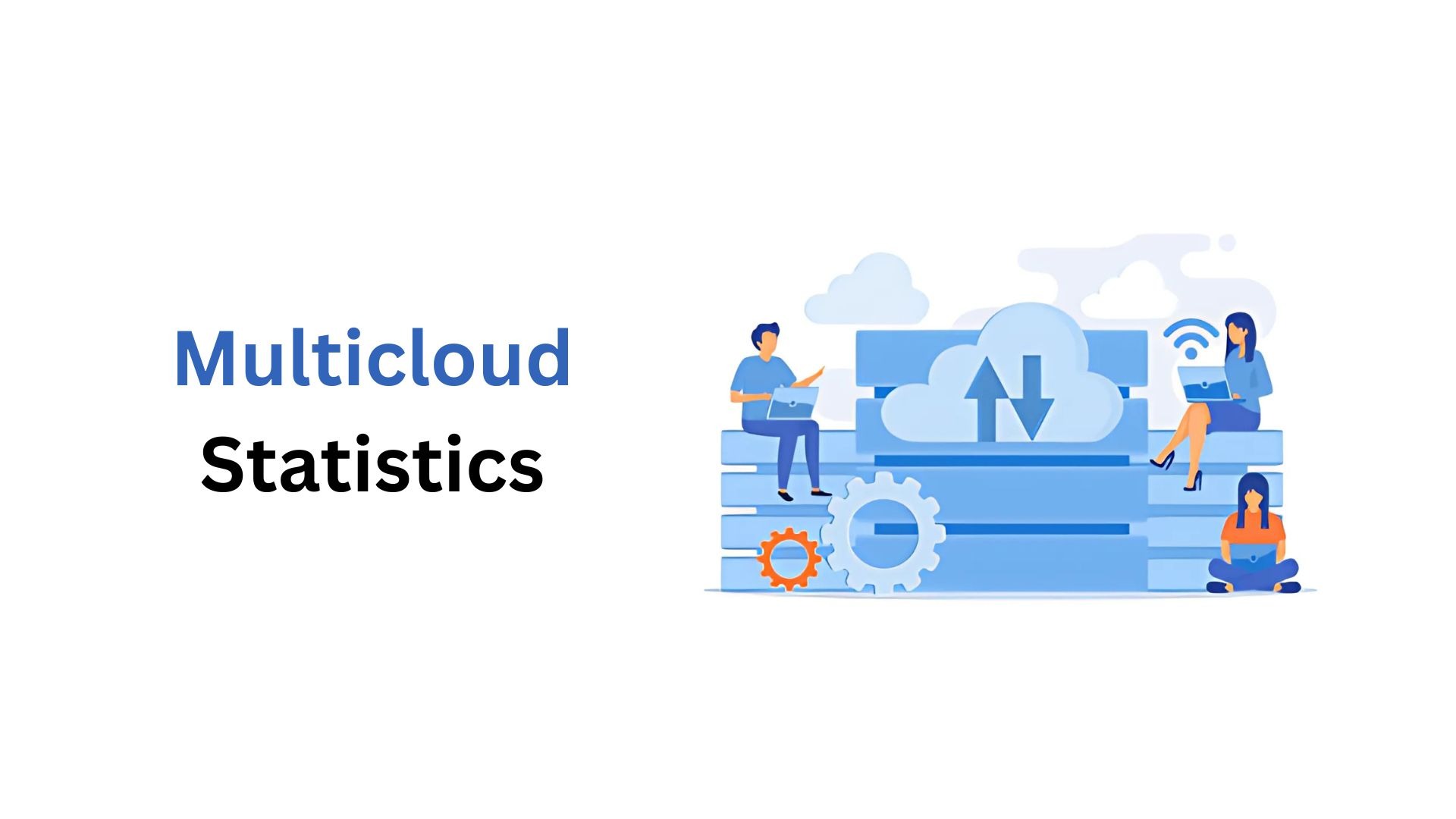
Table of Contents
- Introduction
- Editor’s Choice
- Factors Impacting the Multicloud Market
- Global Multicloud Networking Market Size
- Segmental Analyses of the Multicloud Market
- Multi-cloud Management Market Size Analysis
- Multi-cloud Management Market Share by Region
- By Enterprise Size
- By End-User Industry
- By Development Type
- Multi-Cloud Adoption Statistics
- Worldwide IaaS and PaaS Hyperscaler Market Share by Vendors
- Public Cloud Spending and IaaS Growth Analyses
- Public Cloud PaaS End-User Spending Statistics
- Global SaaS End-User Spending Growth Analyses
- Multicloud Usage Statistics
- Benefits of Multicloud
- Challenges of Multicloud
- Recent Development
- Conclusion
Introduction
Multicloud Statistics: Multicloud is no longer something new, as it has turned into an important strategy for today’s businesses. Rather than relying on just one cloud provider, many companies now combine services from AWS, Microsoft Azure, Google Cloud, and others. This approach gives them more flexibility, lowers expenses, reduces risks, and allows access to the latest cloud-based tools and technologies.
By 2025, most organisations are expected to run workloads across two or more clouds, showing the growing need for interoperability and independence from single vendors. Recently, businesses have been adopting multicloud to improve disaster recovery, along with meeting regional compliance. In this technologically advancing generation, the adoption of multicloud is rising across global industries such as healthcare, finance, retail, and manufacturing, shaping the future of cloud computing.
Editor’s Choice
- According to market.us, the Multi-cloud Networking market size is predicted to grow from USD 7.43 billion in 2025 to USD 49.29 billion by the end of 2034.
- As of 2024, the global multi-cloud management market was valued at USD 12.52 billion.
- A report published by Precedence Research shows that the North America region accounted for the biggest revenue share of 36% in 2024.
- As of 2024, large enterprises accounted for the largest share at 59% in the Multicloud market.
- In the same duration, the BFSI sector accounted for 22.4% of the multi-cloud market.
- Besides, the private deployment model held a 56.4% share of the multi-cloud market.
- A report published by newhorizons.com states that with multi-cloud adoption growing, more than 90% of companies already use some form of cloud service.
- AWS stayed on top of the global IaaS and PaaS hyperscaler market, with a 31% share in Q4 2023, which then shifted slightly to 30% in Q4 2024.
- Public cloud end-user spending is expected to climb to around USD 723.4 billion by 2025.
- In 2024, the worldwide PaaS market across all deployment types reached USD 144.91 billion.
- Overall public cloud spending, with SaaS as a major contributor, is expected to reach nearly USD 723.4 billion by 2025.
- As of 2024, almost 86% of companies expect to migrate to a multi-cloud system.
Factors Impacting the Multicloud Market
- As mentioned in Mordor Intelligence, the rapid avoidance of vendor lock-in leads with an 8.5% influence.
- AI-driven workload-placement engines follow at 7.8%, helping optimise efficiency.
- The growing demand for cloud-native disaster recovery contributes 6.2%.
- Meanwhile, sovereign-cloud mandates in regulated regions such as the EU and the Middle East add 5.4%.
- Hyperscaler interconnect fee optimisation impacts growth by 4.7%, and rising needs for carbon-aware orchestration account for 3.2%.
Global Multicloud Networking Market Size
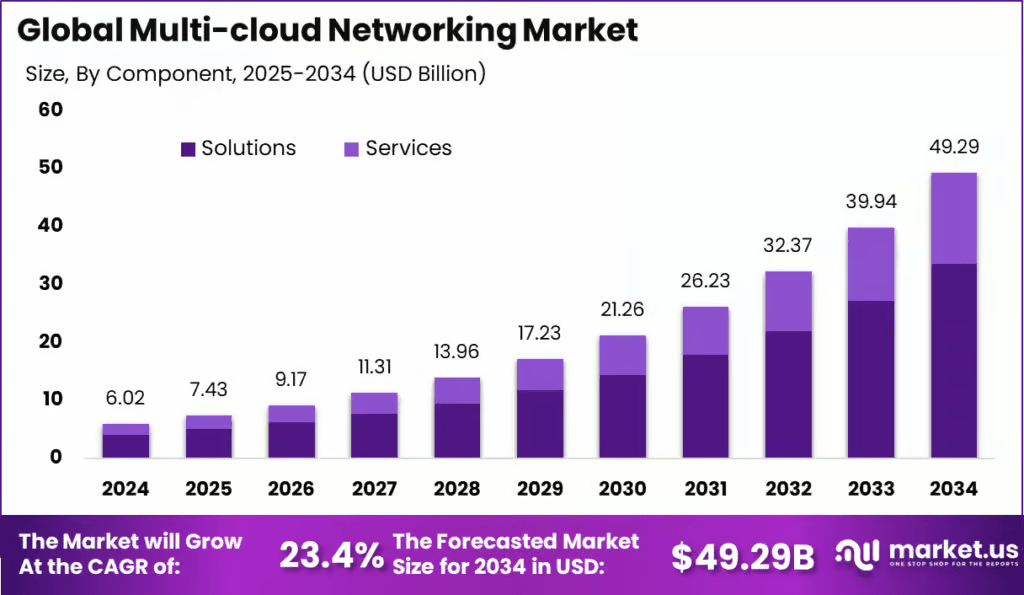
- According to market.us, the Multi-cloud Networking market size is predicted to grow from USD 7.43 billion in 2025 to USD 49.29 billion by the end of 2034.
- This market is representing a growth rate of 23.4% CAGR from 2025 to 2034.
- The above graph also estimates the market size in the coming year, followed by 2026 (USD 9.17 billion), 2027 (USD 11.31 billion), 2028 (usd 13.96 billion), 2029 (USD 17.23 billion), 2030 (USD 21.26 billion), 2031 (USD 26.23 billion), 2032 (USD 32.37 billion), and 2033 (USD 39.94 billion).
Segmental Analyses of the Multicloud Market
- A report published by market.us stated that in 2024, the Solutions segment held the top position in the global multi-cloud networking market with 68.1%.
- The Public Cloud model accounted for 62.3%, making it the most preferred choice for deployment.
- Large enterprises represented 72.4%, proving strong usage among big organisations.
- The IT & ITeS sector contributed the largest industry share at 24.5%. In the U.S., the market reached USD 2.19 billion, expanding at a 21.6% CAGR.
- The North American region stayed ahead globally, securing a market share of 1% in 2024.
Multi-cloud Management Market Size Analysis
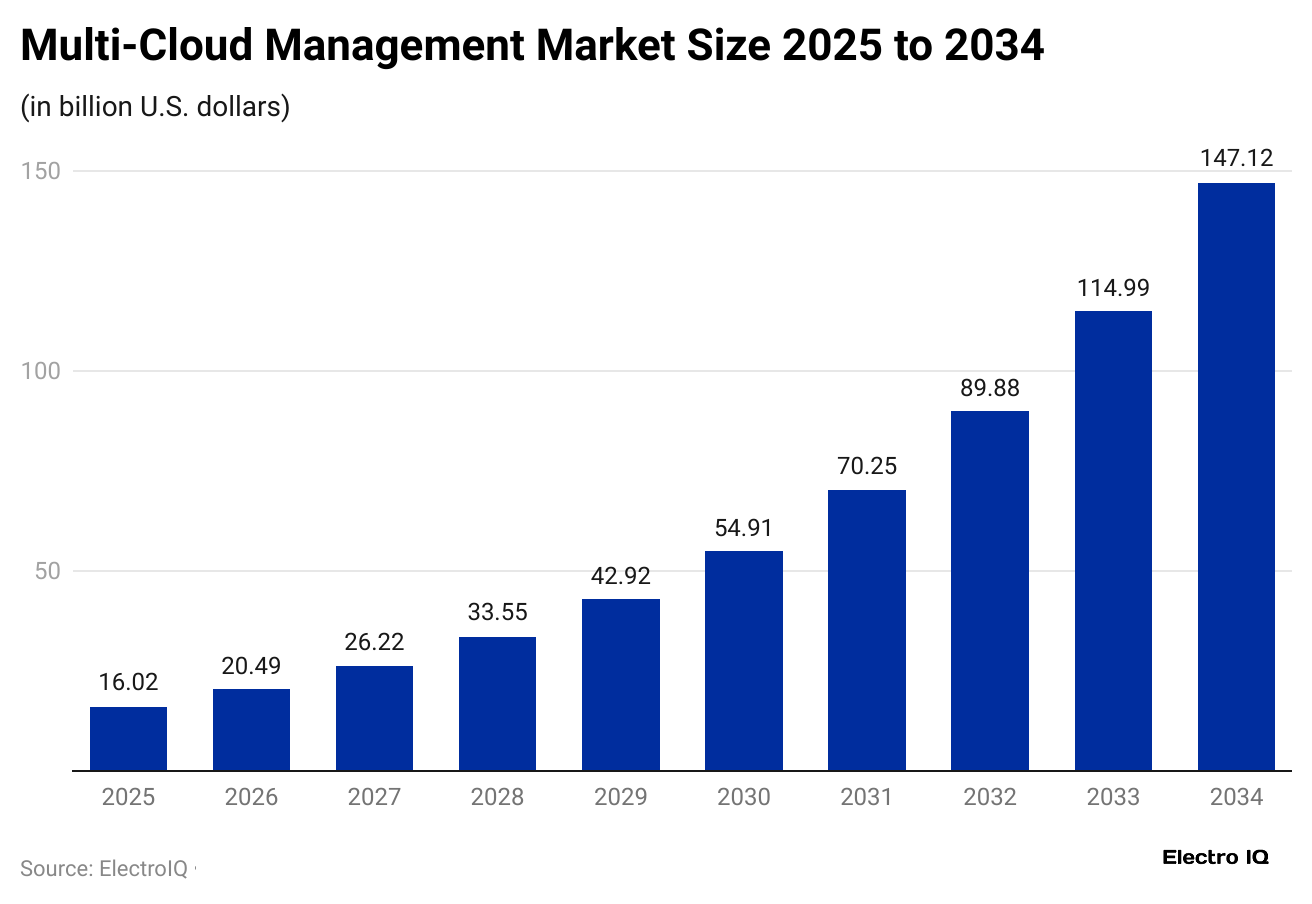
- As of 2024, the global multi-cloud management market was valued at USD 12.52 billion.
- It is expected to grow to USD 16.02 billion in 2025 and may reach nearly USD 147.12 billion by 2034, showing a CAGR of 27.94% from 2025 to 2034.
- Moreover, the market size in the coming years are predicted to be USD 20.49 billion (2026), USD 26.22 billion (2027), USD 33.55 billion (2028), USD 42.92 billion (2029), USD 54.91 billion (2030), USD 70.25 billion (2031), USD 89.88 billion (2032), and USD 114.99 billion (2033).
- In 2024, North America led the multi-cloud management market, generating 36% of total revenue.
- The cloud automation category made up 27%, while large companies contributed 59%.
- Among industries, banking, financial services, and insurance (BFSI) represented 26% of revenue.
- The United States multi-cloud management market is expected to be about USD 4.33 billion in 2025 and may grow to nearly USD 40.54 billion by 2034, with a CAGR of 28.20%.
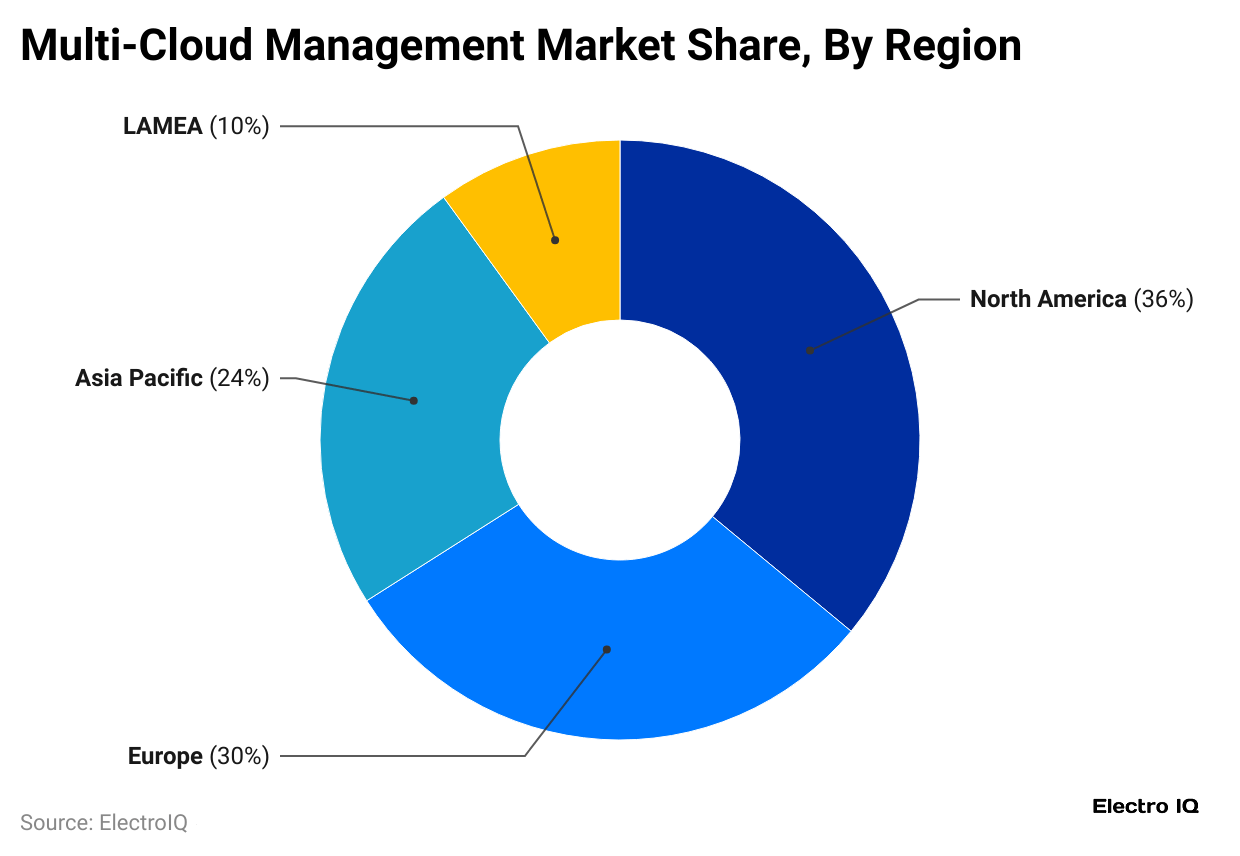
- A report published by Precedence Research shows that the North America region accounted for the biggest revenue share of 36% in 2024.
- Furthermore, other regions’ market shares are followed by Europe (30%), Asia Pacific (24%), and LAMEA (10%), in the same duration.
By Enterprise Size
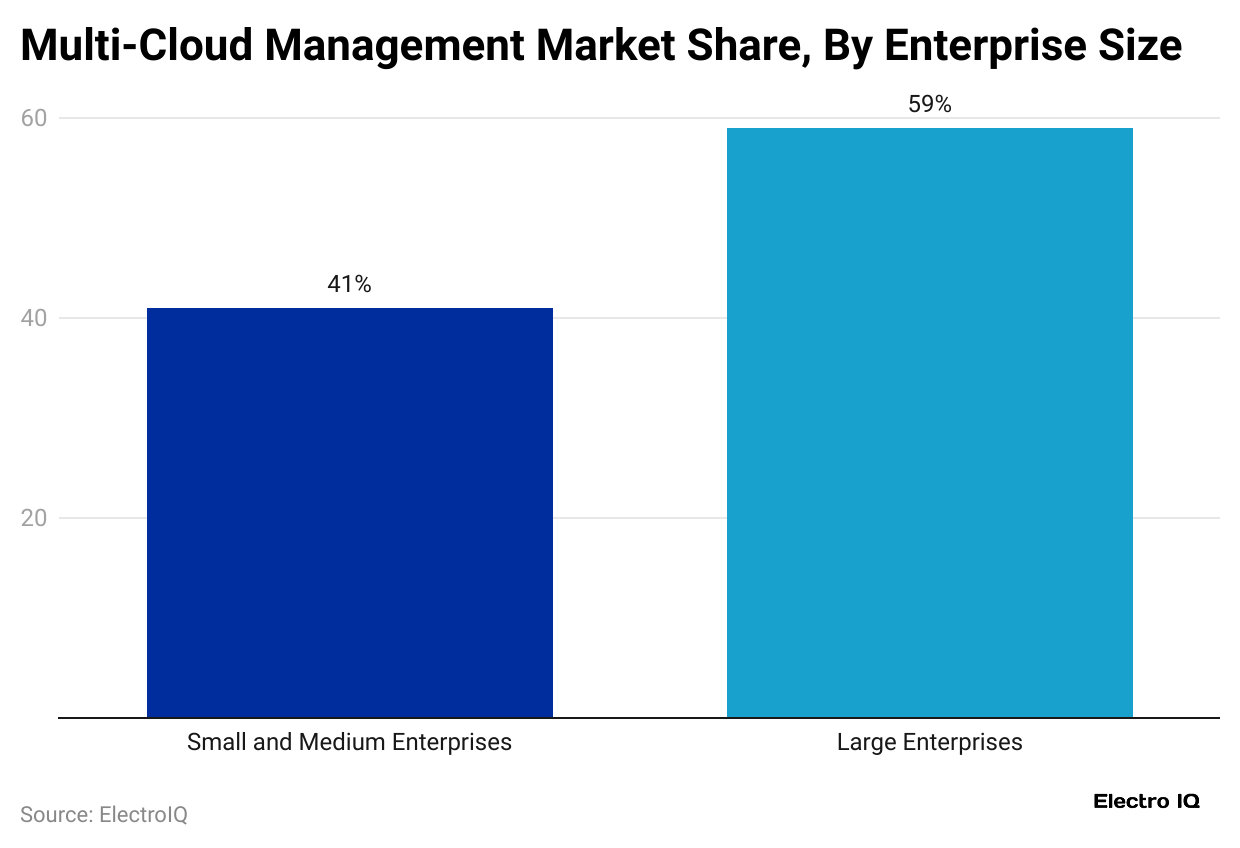
- As of 2024, large enterprises accounted for the largest share at 59% in the Multicloud market.
- In contrast, small and medium enterprises made up the remaining 41% of the market.
By End-User Industry
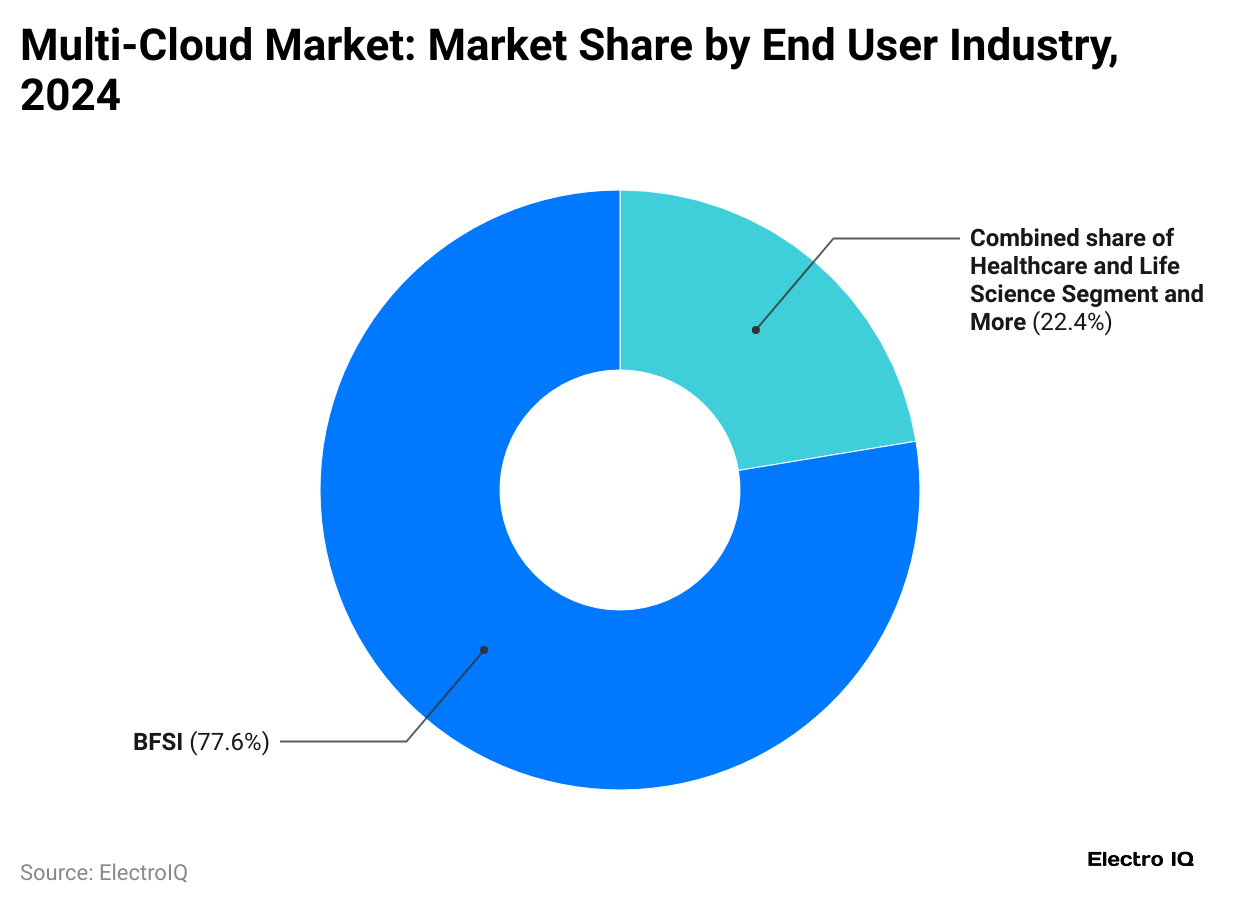
- In 2024, the BFSI sector accounted for 22.4% of the multi-cloud market.
- The combined share of healthcare, life sciences, and other industries dominated with 77.6%.
By Development Type
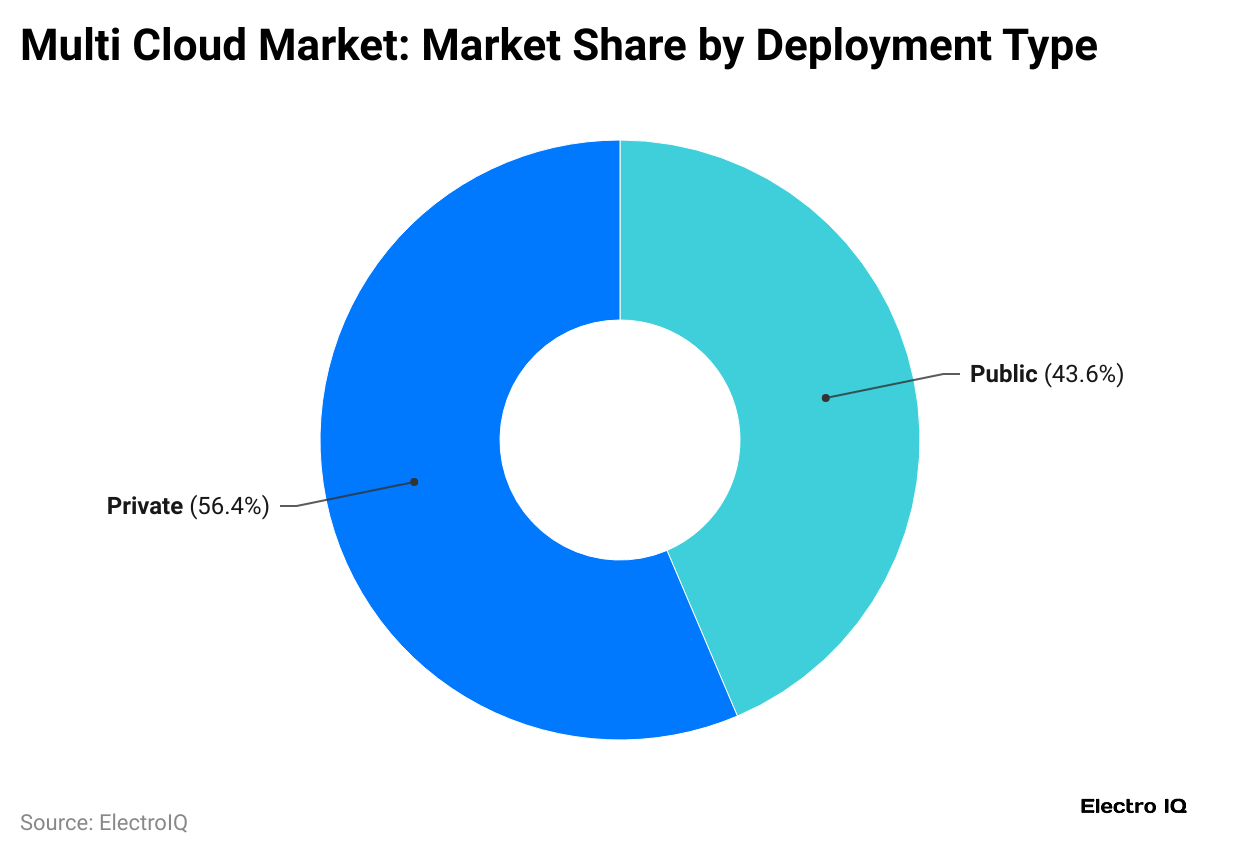
- In 2024, the private deployment model held a 56.4% share of the multi-cloud market.
- Meanwhile, the public deployment model accounted for 43.6%, reflecting steady demand.
Multi-Cloud Adoption Statistics
- A report published by newhorizons.com states that with multi-cloud adoption growing, more than 90% of companies already use some form of cloud service.
- Flexera’s 2024 State of the Cloud survey shows that 97% of IT professionals plan to adopt multi-cloud within a year.
- By next year, 54% of organisations expect to shift their workloads to cloud-based systems.
- A n2ws.com report further showed that the 2024 State of the Cloud report highlights strong growth in cloud adoption.
- About 89% of businesses now use multi-cloud setups, while 73% rely on hybrid models.
- Additionally, 58% of organisations are planning to expand their cloud workloads.
- According to a Statista report, AWS stayed on top of the global IaaS and PaaS hyperscaler market, with a 31% share in Q4 2023, which then shifted slightly to 30% in Q4 2024.
Other vendors’ market shares are mentioned in the table below:
| Vendor | Q4, 2024 | Q4, 2023 |
| Microsoft Azure | 21% |
24% |
|
Google Cloud |
12% | 11% |
| Alibaba Cloud | 4% |
4% |
| 3% | 2% | |
| IBM Cloud | 2% |
2% |
| 2% | 3% | |
| Others | 26% |
23% |
Public Cloud Spending and IaaS Growth Analyses
- According to CloudZero, public cloud end-user spending is expected to climb to around USD 723.4 billion by 2025.
- IO reports that the worldwide cloud infrastructure market, which includes IaaS, PaaS, and hosted private cloud, was valued at nearly USD 330.4 billion in 2024.
- Meanwhile, TechJury notes that the IaaS segment will grow at a 26.2% CAGR, reaching about USD 180 billion by 2025.
Public Cloud PaaS End-User Spending Statistics
- In 2024, the worldwide PaaS market across all deployment types reached USD 144.91 billion, according to Fortune Business Insights.
- Gartner reports that global public cloud PaaS spending was about USD 171.56 billion in 2024.
- Meanwhile, it is expected to grow by 21.6% in 2025, climbing to nearly USD 208.64 billion.
Global SaaS End-User Spending Growth Analyses
- A report published by Demand Sage shows that in 2015, spending on SaaS services worldwide was about USD 31.4 billion, and by 2023, it had increased to USD 206 billion.
- The figure reached around USD 247.2 billion in 2024.
- According to CloudZero, overall public cloud spending, with SaaS as a major contributor, is expected to reach nearly USD 723.4 billion by 2025.
Multicloud Usage Statistics
- A report published by New Horizons stated that in 2023, 76% of organisations used a multi-cloud strategy.
- As of 2024, almost 86% of companies expect to migrate to a multi-cloud system.
- A cloudcomputing-news.net report shows that around 62% of organisations are already using a multi-cloud environment.
- 18% are actively transitioning to multi-cloud.
- 64% expect their multi-cloud use to increase in the next two years.
- 3% believe their multi-cloud usage will decrease in the next two years.
- Fewer than 1% have no plans to adopt multi-cloud.
- 50% recognise flexibility (right workload on right cloud) as the main strength.
- 41% value improved agility.
- 40% highlight cost-effectiveness and access to better infrastructure.
- 39% see reduced organisational risk as a benefit.
- 27% cite technical complexity as a key challenge.
- 31% are concerned about more endpoints and security vulnerabilities.
- 46% admit they are still “on the road” to multi-cloud adoption.
- 23% report their multi-cloud use is “plain sailing” with significant benefits.
Benefits of Multicloud
- The system is flexible and can grow or shrink as needs change
- Backup options keep work steady and reduce mistakes.
- It saves money compared to costly tools.
- Speed and efficiency stay high. Built-in security lowers risks and meets rules.
- It supports fresh ideas and runs continuously without downtime.
Challenges of Multicloud
- Managing many cloud platforms is not simple.
- Companies face challenges like security risks, data rules, and connecting different cloud systems.
- Teams often lack the required skills, which increases problems.
- Costs can also grow quickly if usage is not controlled.
- Handling all these together makes cloud management a big task.
Recent Development
- In August 2024, Hewlett Packard Enterprise acquired Morpheus Data, adding multicloud orchestration and FinOps features to GreenLake.
- In October 2024, Cisco concluded its deal for CloudBolt Software, boosting governance and cost-optimisation within Cisco Intersight.
- In January 2025, Google Cloud completed the CloudSimple acquisition, strengthening Anthos with VMware migration tools.
- In February 2025, IBM finalised the USD 6.4 billion takeover of HashiCorp, bringing Terraform and Vault into its hybrid-cloud automation portfolio.
Conclusion
Multicloud means using more than one cloud provider to manage IT systems. Instead of depending on a single platform, companies adopt multiple clouds to stay flexible, cut risks, and lower expenses. Reports show that hybrid and multicloud setups are becoming more common as businesses look to improve performance, meet compliance needs, and encourage innovation.
However, challenges remain, including higher costs, integration issues, and difficult management. Security and proper data handling also raise concerns. Despite these hurdles, multicloud is emerging as a long-term approach that helps organisations stay agile and increases the demand for better tools.
Sources
FAQ.
Companies choose multicloud for flexibility, better performance, cost savings, and to reduce vendor lock-in.
The key benefits include agility, resilience, improved compliance, and the ability to innovate faster.
The biggest challenges are integration issues, higher costs, complex governance, and security risks.
Each user can upload up to 750GB of data per day, and while a single file can be as large as 5TB, only the first file bigger than that will upload successfully.
Tracking multicloud costs is hard because providers use different pricing models, billing formats, and hidden charges.

Maitrayee Dey has a background in Electrical Engineering and has worked in various technical roles before transitioning to writing. Specializing in technology and Artificial Intelligence, she has served as an Academic Research Analyst and Freelance Writer, particularly focusing on education and healthcare in Australia. Maitrayee's lifelong passions for writing and painting led her to pursue a full-time writing career. She is also the creator of a cooking YouTube channel, where she shares her culinary adventures. At Smartphone Thoughts, Maitrayee brings her expertise in technology to provide in-depth smartphone reviews and app-related statistics, making complex topics easy to understand for all readers.





